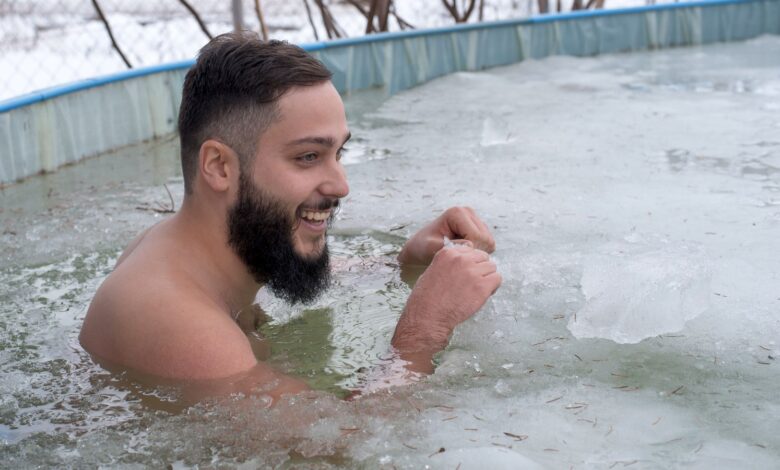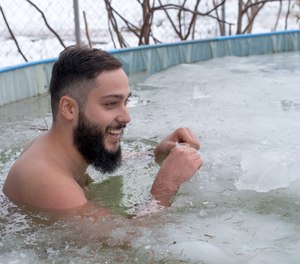How police officers can get the most out of cold water therapy

Cold water therapy has been a proven way to promote a healthy mental and physical life. But getting yourself fully immersed in a near-freezing tank of water is no easy task and, for many, too difficult to do without guidance.
This article will cover the three not-so-scientific stages of cold water therapy, the proper water temperature settings and a few tips that can keep you submerged longer.
UNDERSTANDING THE THREE STAGES OF COLD water THERAPY

Cold water therapy has been a proven way to promote a healthy mental and physical life. (Photo/Getty Images)
I wish someone would have explained what my body was going to go through when I took the plunge.
Below are the three stages a person will go through when they jump into a tank of ice-cold water. The stages will help you understand what your body is going through and what to expect during a successful cold plunge session.
- Stage 1: “I’m gonna die”: When your body becomes fully submerged (up to the base of the neck), your vagus nerve activates and sends an emergency signal to the mind to get out. I instantly regretted my first time and wanted nothing more than to just get out. This signal is truly a fight-or-flight situation and is designed to keep a person alive during a stressful situation. But being uncomfortable and fighting through this physiological response can reap huge benefits for both your health and mind. It has been my experience that too many users of cold water therapy jump out too early. Taking a dip in ice water is different than staying in ice water. You won’t receive the same therapeutic response if you get out too early.
- Stage 2: “Wow, it’s cold”: After your mind realizes that you are not going to die and you are simply uncomfortable, it starts to relax. Your mind thought you were going to die and you didn’t. Congratulations. Stage 2 is where you will see most of the psychological benefits.
During Stage 2, you will suddenly notice something: you’re cold. Your brain shifts from fight-or-flight to “Wow, it’s cold.” You will start to shiver and your body may cramp up. These are all normal responses. Your body knows you are not going to get out and is trying to warm you up.
- Stage 3: “This is relaxing”: You want to get to Stage 3. During Stage 3, your mind is under control, your body doesn’t feel cold and your body starts to relax. This feeling is oddly like that of a relaxing sauna or hot tub. Once you make it to Stage 3, you technically have reached the point where you received all the benefits of an ice bath.
Be careful in this stage, because your body is truly relaxed. All your aches and pains will go away and it is almost a euphoric feeling. You may be tempted to stay in longer, but staying in too long can cause significant damage to your body tissues and could cause hypothermia.
PROPER TEMPERATURE AND HOW LONG YOU SHOULD STAY IN ICE WATER
Cold water therapy without stimulating the vagus nerve will not bring you the results that you are wishing for. If you don’t stimulate the vagus nerve, then it is very similar to placing your foot in ice water after rolling your ankle. Great for the ankle, and that is about it.
The vagus nerve is stimulated by cold on the lower neck and trapezius. That is why you will want to completely immerse yourself in the cold water. Try to get your shoulders under the water.
When starting cold water therapy, you will have a significant advantage if you just make your own cold plunge. This way, adjusting the temperature is much easier than if you use one at the gym or health center (where the temperature is set).
There is a lot of debate on the proper temperature for cold water therapy, but scientists say an ideal cold water therapy session should be between 45°F (7°C) and 55°F (13°C) for a short period of time. As a starter, shoot for 55°F. Once your body and mind adjust to a higher temperature, lower the temperature to your desired level of coldness.
The time you spend in the cold water should be determined by what your body or mind is going through that day or week and how long it takes you to get to Stage 3. Remember, once you make it to Stage 3, most of the mental and physical benefits are already over. However, if you have high levels of inflammation in your body, dense muscles or experience trauma, feel free to stay longer. My typical session is about 15 minutes and Stage 3 starts around seven minutes for most.
SIMPLE TOOLS TO HELP when taking an ice bath
There are three tips that I give every serious cold water therapy user. These tips will greatly increase your chance of success and turn a somewhat tortuous situation into a therapeutic one.
- Tip 1: Just breathe: When you first get fully submersed into a cold plunge, you may feel like the wind was taken out of you. This response is completely normal but not ideal. When a person experiences extremely cold environments, the body will quickly use up the available oxygen in the blood. If you find yourself short on breath, remember the combat breathing you were taught in the police academy. Your goal should be to recover your breath within the first two minutes. You will never transition into Stage 2 if you can’t catch your breath.
Something that has helped me more than combat breathing is learning more advanced breathing techniques like the Wim Hof Method. For cold water therapy, Wim Hof recommends taking repetitive deep breaths. When you take deep, fast breaths, it overloads your blood with oxygen. So, when you get in, take deep breaths to ensure your body doesn’t struggle to recover its breath.
- Tip 2: Wear toe sleeves: Once you get into Stage 3, your body will relax but you may experience a sharp, excruciating pain. That pain is the slow freezing of your toes and hands. The freezing of your toes and hands is also the biggest concern for doctors, because sustained colds on these parts can cause damage to the tissues and joints – which may lead to arthritis. A simple solution to protecting your toes is to wear neoprene toe sleeves. These covers go over your toes and protect them from the cold. Your toes stay warm while you freeze the rest of your body. I doubled my time in the cold plunge simply because I covered my toes.
To protect the hands, simply keep them out of the water. If you have a lot of inflammation in your hands, feel free to keep them under the water, but once they start to hurt, just remove them.
- Tip 3: Always tell someone you’re taking an ice bath: Don’t use a cold plunge without telling someone. I always tell my wife or kids to come get me if I am not out within 30 minutes. Once my body relaxes in Stage 3, it is extremely hard for me to get out. All my aches and pains are gone and I just want to hold onto that pain-free feeling for as long as I can. But if I don’t force myself to get out, I run the risk of long-term injury. Always tell someone and always set a timer.
Conclusion
Cold water therapy triggers a range of physiological and psychological benefits, making it an ideal adjunct therapy for first responders who face constant physical and mental challenges in their line of duty. If you follow these tips, you will not only have a better chance for success, but you will maximize the results and have an overall better experience.
NEXT: How to build an ice bath: A comprehensive guide to convert a chest freezer into a cold plunge




